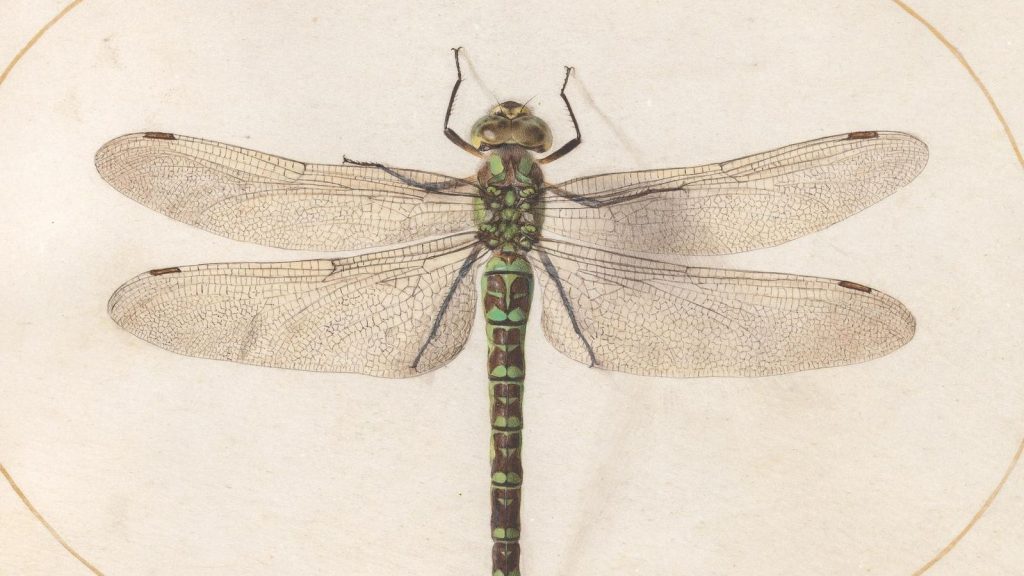Working as a merchant in 16th century Antwerp, Joris Hoefnagel saw the world through the medium of trade. He encountered luxurious objets d’art crafted with exotic wood and shell. But his eyes were drawn most of all to natural history specimens he considered to be God’s own creations.
Over several decades, he rendered them in watercolor on parchment or vellum. He called his collection The Four Elements, associating mammals with earth, birds with air, and fish with water. But it was the insects that received his greatest devotion. Without comment, he associated them with fire.
Joris Hoefnagel. Animalia Rationalia et Insecta (Ignis), c. 1575/1580, bound volume of 78 drawings in watercolor and gouache. National Gallery of Art, Gift of Mrs. Lessing J. Rosenwald 1987.20.5
National Gallery of Art
No explanation was needed. A rare opportunity to view pages from The Four Elements at the National Gallery of Art in Washington DC reveals an almost alchemical process by which Hoefnagel captured the preternatural iridescence of butterflies and beetles. Rendered in Hoefnagel’s meticulous hand, often using brushes with just a few bristles and sometimes animated with teeny flecks of gold, the “little beasts” (as insects were known at the time) appear to be aflame.
And yet for all the magic of the painting, Hoefnagel never surrendered to fantasy. Unlike the whimsical objets d’art he handled in trade, his images are accurate enough that exhibition co-curators at the National Museum of Natural History can confidently name the species.
By contemporary standards, Hoefnagel is a study in contradictions. His scientific precision was inspired by religious devotion. His artistic creations pay homage to the Creator. Closer examination reveals tensions that are more subtle but no less profound. One of the most surprising is his choice of materials. It’s not just the artifice of making critters come to life with sprinkles of gold leaf. Several of the watercolors turn out to be composite images constructed in part from bits of his specimens. With Hoefnagel’s help, these little beasts represent themselves.
The apparent contradiction of scientific inquiry motivated by religious faith is easily resolved when you consider that science emerged from religion, and only recently sought explanations independent of faith. There’s also a long history of art serving religion. Humans have often paid homage to the miraculous by emulating it.
But Hoefnagel’s hybrid watercolors are not so easily contextualized (even if some of the techniques were also used by other artists of the period). Since the Renaissance, objects of wonder were categorized as naturalia or artificialia. The former included crystals and shells and animal pelts. The latter were the products of artisans, who might denature naturalia by embedding specimens in lavish settings or might transform natural materials beyond recognition. Although artificialia often emulated naturalia in whimsical ways, the artifice was the source of delight. Some of the finest artifacts were just noticeably different from their inspiration, simultaneously paying homage to the artisan and the natural specimen.
In concept and in practice, Hoefnagel’s hybrids are the opposite. When he outfits real dragonfly wings with a watercolor body and legs, he naturalizes artificialia and vice versa. What we admire is the composite, which we see as autonomous.
Hoefnagel’s hybrids were feasible because his subjects were small. Little beasts were well suited to life-size depiction, making their bodies interchangeable with their rendering (especially parts of their anatomy that were essentially two dimensional). Optical devices developed in Hoefnagel’s era enhanced observation, while simultaneously augmenting the sense of awe that humans have had for these diminutive life forms since antiquity. (“We make a wonder at the monstrous and mightie shoulders of Elephants” wrote Pliny the Elder in the Naturis Historia. “We keepe a woondring at the ravenings of tygres, and the shag manes of Lions: and yet in comparison of these Insects, there is nothing wherein Nature and her whole power is more seen, neither sheweth she her might more than in the least creatures of all.”)
Jan van Kessel the Elder. Insects and a Sprig of Rosemary, 1653, oil on copper. National Gallery of Art, The Richard C. Von Hess Foundation, Nell and Robert Weidenhammer Fund, Barry D. Friedman, and Friends of Dutch Art 2018.41.1
National Gallery of Art
Whether or not Hoefnagel’s little beasts were inspired by the Naturis Historia or other ancient sources, his artworks clearly express a Christianized version of Pliny’s panegyric, and provide a timely reminder of insects’ significance as modern humans decimate global populations of butterflies and bumblebees. The same can be said about other works in the National Gallery exhibition, such as the 17th century panels of Jan van Kessel.
But the greater significance of The Four Elements is the challenge Hoefnagel presents to the distinction between naturalia and artificialia, a dichotomy that continues to play a role in the spurious separation of humankind from the natural world. Even if the insects didn’t voluntarily participate in their creation, the hybridity of Hoefnagel’s composites defies classification. The works provide a vision as salient now as ever. In earth, air, water, and especially fire, we share the materials to forge a common future.
Full Disclosure: I am a 2025 Smithsonian Artist Research Fellow. Although my research is based at the National Museum of Natural History, it’s unrelated to this exhibition.

